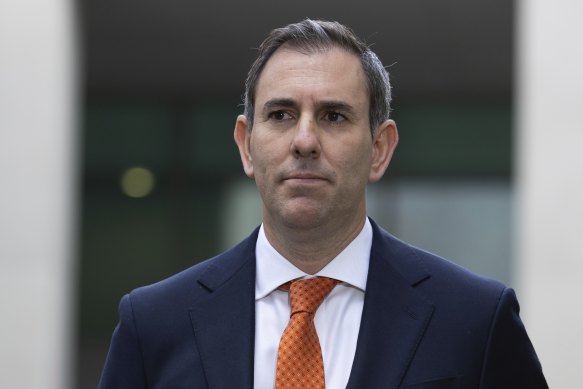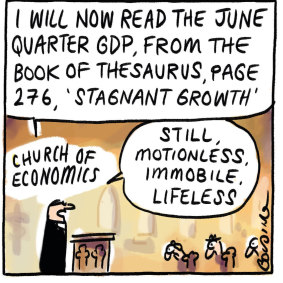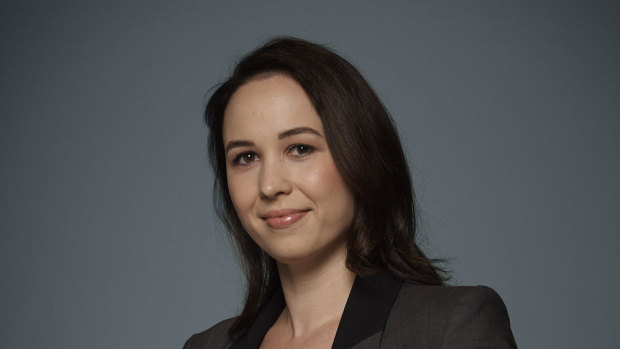This was published 7 months ago
‘Smashed’ economy slows like it’s 1991
By Shane Wright and Millie Muroi
The national economy has ground to a halt, propped up by government cash and immigration while households slash spending as they experience recession-like conditions that may force the Reserve Bank to re-think its position on interest rates.
In a blow to the Albanese government’s economic credentials, figures from the Australian Bureau of Statistics on Wednesday showed the economy grew by just 0.2 per cent in the June quarter, taking annual growth down to 1 per cent last financial year. It was the weakest performance by the economy, outside of COVID, since the 1991 recession.

Treasurer Jim Chalmers is faced with an economy that is barely growing.Credit: Alex Ellinghausen
If not for population growth, the result would have been worse. GDP per person fell for a record-breaking sixth consecutive quarter, with output per capita in its deepest nose-dive since the 1981-82 recession.
Treasurer Jim Chalmers used the results to justify his remark on Sunday that interest rate rises had “smashed” Australia’s economy, which sparked a political firestorm over the appropriateness of blaming the Reserve Bank for the state of the economy.
“[My remarks] have been borne out again in the national accounts,” Chalmers said, naming global uncertainty and inflation as other factors hurting the economy.
The poor result is being driven by households who cut spending by 0.2 per cent in the three months to the end of June. Expenditure on food, alcohol, clothing, footwear, cafes, hotels and the purchase of new cars all fell with spending on discretionary goods down by 1.1 per cent.
Over the past 12 months, consumers have sliced discretionary spending by 2.9 per cent and expenditure on necessities by 1.1 per cent. In a sign of consumers’ financial pressures, the household savings ratio fell to 0.6 per cent, one of its lowest levels since the Global Financial Crisis.
Chalmers conceded the figures showed the economy was barely growing with only government spending – which increased by 1.4 per cent in the quarter – preventing an outright contraction.
“This justifies the way that we’ve managed the economy responsibly – fighting inflation as our primary concern but doing that without slashing and burning in a budget, in an economy which is already weak and when people are already doing it tough,” he said.
But shadow treasurer Angus Taylor said households were in a recession that had been going on for 18 months.
“We haven’t seen that in the 50 years we’ve been keeping records on this. This is a real recession, and you can’t pretend otherwise through an immigration rate which is way above what our housing supply can support,” he said.
A key measure of living standards, net disposable income per person, fell to its lowest level since before the pandemic to just $17,256. A year ago it was $17,728.
At the state and territory level, final household spending suffered its biggest fall in NSW, down by 0.6 per cent, while it dropped by 0.3 per cent in the ACT and South Australia, by 0.2 per cent in Tasmania and by 0.1 per cent in Victoria.
It was up by 0.1 per cent in Queensland and the Northern Territory and 0.4 per cent in Western Australia.
Future Fund chair Greg Combet declined to comment on the verbal stoush started by the Treasurer but noted the Reserve Bank had kept jobless numbers low. “To have an unemployment rate of around 4.2 per cent is a good outcome in this environment as well,” Combet said as he announced an update to the fund’s portfolio.

Credit: Matt Golding
The figures also suggest the Reserve Bank’s most recent forecasts for the economy have been too strong – the RBA cash rate has been at 4.35 per cent since November last year. It had expected household spending to grow by 1.1 per cent over the year and the household savings ratio to be around 1.2 per cent.
Senior AMP economist Diana Mousina’s said the figures suggested the RBA would have to re-think its “hawkish” position as the economy did not need higher interest rates.
“Our view is that GDP growth will remain poor over the next six months. Alongside a better inflation outlook, we should see the start of rate cuts from the central bank in February 2025,” she said.
But KPMG chief economist Brendan Rynne said the figures confirmed government spending on labour-intensive public sector services was crowding out the capital-intensive private sector.

AMP economist Diana Mousina says the latest GDP figures show the RBA will have to drop its hawkish outlook for the economy.
“It is a story of a two-speed economy – the private sector of the Australian economy is going backwards, while the public sector is spending big. Clearly this is not sustainable and is effectively taking from Peter to pay Paul,” he said.
Deloitte Access Economics partner Stephen Smith said the fact the economy was relying on government spending to keep growing proved interest rates had done their job.
“Household consumption has fallen in the past three months despite still strong population growth, real retail spending has gone backwards for almost two years now, job creation in white-collar private sector industries has essentially stalled, and business insolvencies have recently hit record highs,” he said.
The poor performance of the economy, and the ongoing threat posed by inflation – which is currently 3.8 per cent – is expected to be touched upon by Reserve Bank governor Michele Bullock when she speaks at a charity function on Thursday.
Cut through the noise of federal politics with news, views and expert analysis. Subscribers can sign up to our weekly Inside Politics newsletter.